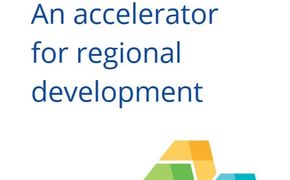On 17 February 2022, the Interreg Europe Policy Learning Platform held an online webinar on ‘Collection and recycling of construction and demolition waste’.
Construction and demolition waste (CDW) accounts for more than a third (35%) of all waste generated in the EU. It contains a wide variety of materials such as concrete, bricks, wood, glass, metals and plastic, including hazardous materials like asbestos. About 450 – 500 million tonnes of CDW are generated annually in the EU. It contains all the waste produced by the construction and demolition of buildings and infrastructure, as well as road maintenance. Technology for separation and recovery of construction and demolition waste is well established, readily accessible and generally inexpensive. Nevertheless, the level of recycling and material recovery of construction and demolition waste varies greatly across the EU, ranging from less than 10% to over 90%.
The Waste Framework Directive has set a target to increase re-use, recycling and recovery of construction and demolition waste to a minimum of 70% by 2020. The directive promotes waste generation reduction and the use of selective demolition to enable removal of hazardous substances. Construction and Demolition Waste Management Protocol (guidelines on CDW management) and guidelines on pre-demolition audits are provided in the Directive. The circular transformation of the construction sector is covered under the Circular Economy Action Plan.
The webinar presented policy measures and circular methods from Interreg projects CONDEREFF, SMART WASTE and CIRCE to improve the collection and recycling of construction and demolition waste in line with the European agenda, aiming to inspire local and regional authorities
Webinar recording
Agenda overview
Concept and moderation by Astrid Severin and Magda Michalikova, Thematic Expert of Environment and resource efficiency
00:02:28 Introduction to the topic by Thematic Expert, Astrid Severin
00:09:05 Presentation by Jean-Benoît Bel on improved resource efficiency through better policies for construction and demolition waste.
00:18:50 Q&A: What are the best incentives that lead to more reuse and recycling of construction and demolition waste?
00:20:41 Q&A: When bricks are collected at the CA site in Denmark and are sent to the brick manufacturing factory at what point do they become end of waste? And does the brick factory need a waste permit?
00:21:34 Q&A: Could you elaborate on the free take back system?
00:24:29 Presentation by Vicente López Mateu on estimating quantities and types of waste in construction.
00:36:01 Q&A: Is the CONDEREFF toolkit available in English and can everyone use it?
00:37:24 Q&A: You mention that local regulations are different in each of the Spanish regions, are there any harmonisation efforts taking place?
00:38:36 Q&A: Have you considered how to link the collected waste to the materials identified in the project and materials in production where the share of the recycled materials are stated?
00:40:11 Presentation by Sara Grassi on Memorandum of Understanding for construction and demolition waste.
00:48:17 Q&A: You already achieved 95% of construction demolition waste going to recovery. Do you think this is due to the Memorandum of Understanding or was it already the case?
00:49:57 Q&A: How did you bring together the different players around your project?
00:53:06 Presentation by Ingrid Winter on Austrian Recycling Building Materials Ordinance
01:05:24 Q&A: You mention that now with the ordinance you have end of waste criteria, is that for all the materials? How did you go about it?
01:08:10 Q&A: You mentioned you reached the highest standard of quality, do you have recommendations on how to reach such quality?
01:10:54 Q&A: Do you have plans for reusing the materials?
01:12:53 Q&A: Can it be interpreted that waste materials are reused in construction as waste if it doesn't reach declassification as UA?
Panel discussion
01:14:52 Q&A: The EU considers back filling of construction and demolition waste as recovery and has set a joint commitment for reuse, recycling and recovery including back filling at 70% of the weight of this weight. This makes it possible to load old queries and open mines with this waste which is against recycling. What is your experience with back filling?
01:22:35 Q&A: What would be three key issues that urgently need to be addressed to increase the reuse and recycling rates of demolition and construction waste.
Key learnings:
The construction sector has a big impact on the environment, not only because of the large amounts of waste generated, but also through high resource consumption: energy, water and materials. Therefore, there is a need to make the entire industry circular. Jean-Benoît Bel from ACR+ shared several inspirational examples:
- Collection and closed-loop recycling of gypsum waste in the Dutch municipality of Reimerswaal.
- Collection and closed-loop recycling of bricks on a local scale in Odense, Denmark.
- Policy instruments such as bans and taxes on landfilling and waste, pre-demolition audits, end-of-waste criteria and certification, application of re-used materials etc., which are in place in Flanders, Belgium.
- Re-use and material exchange platforms in the Brussels region.
Among elements key to circular construction are tools enabling the identification of empty buildings, mandatory pre-audits, mandatory use of recycled materials (concrete), cradle to cradle approach – eco-design of new buildings. ACR+ has Sustainable construction guidelines for local and regional authorities.
Related links:
Examples from Spain
An important part of construction and demolition waste management is estimating the quantity and type of material. In Spain, municipalities can use a manual for that, developed by the Polytechnic University of Valencia. There is also an online app which provides information on how different waste materials can be recycled and helps find companies who can recycle or re-use them. According to Vicente López Mateu, it is vital to carry out a proper initial analysis, have tools that help manage CDW properly, provide the technology to municipalities free of charge and establish better governmental control and monitoring.
Related links:
- Survey from Natural Resources Wales, where companies fill out the quantities of CDW
- Database of CDW rates in Mallorca
Memorandum of Understanding from Lombardy
There are three main issues with construction and demolition waste:
- lack of awareness of recycled aggregates due to insufficient information dissemination within the sector.
- use of recycled materials not promoted enough in public tenders.
- outdated national waste recovery legislation.
To address these issues, the region of Lombardy has signed a “Memorandum of Understanding”. Its main accomplishments include research studies aiming to identify factors limiting the use of recycled materials in construction, appeals for tenders and incentives to encourage the use of recycled aggregates, training activities, and the development of a digital marketplace.
Related links:
Austrian Recycling Building Materials Ordinance
The Austrian Recycling Building Materials Ordinance has been introduced in reaction to past challenges faced in construction and demolition waste collection and recycling. Among these were:
- the presence of hazardous substances in the waste
- low quality of recycled aggregates
- low cost of primary resources combined with high landfilling fees incentivising low quality recycling
- a limited range of applications for some recycled materials and their subsequent surplus on the market
- no end-of-waste criteria and legal uncertainty.
The ordinance has led to the introduction of pre-demolition audits, improved quality standards, as well as recycling input quality. The quality of most recycled materials has since been declared top-grade, with recycling rates reaching 88%. Austria still needs to establish closed loops for different materials and increase focus on re-use.
Related links:
Panel Discussion
The webinar closed with an interesting panel discussion and questions from the audience. All speakers shared their key recommendations:
- Need for end-of-waste criteria and better harmonisation thereof
- Necessity for economic instruments.
- Promotion of incentives and green public procurement.
- Market conditions prioritising the use of recycled materials to boost circular economy.
- Coordination of national and international regulations.
- Laws on construction and demolition waste.
- Material traceability.
Previous episodes
Find the previous episodes of the waste management series here:
- Meeting the bio-waste challenge
- Collection and recycling of plastics waste
- Collection and recycling of waste from electrical and electronic equipment









